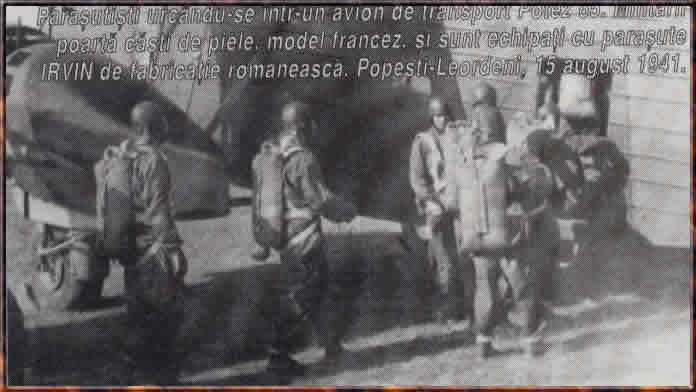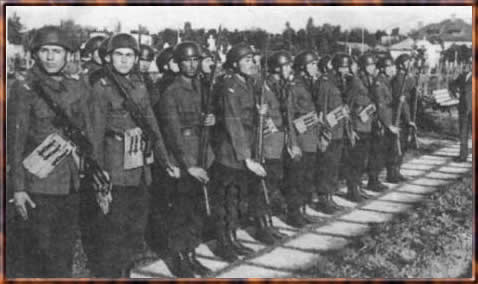However, the best known battles of that day for the 4th Paratroop Battalion,
are the infamous clashes with the men of the Waffen SS's 500th Paratroop
Battalion Here are the events as recorded in the Romanian archives:
in the morning of August the 24th, two Junkers Ju-52 aircraft carrying
elements of the Waffen SS's 500th Paratroop Battalion attempted to land
on the airfields of Boteni and Tântareni. The German soldiers
were tasked with securing the airfields and destroying all the Romanian
aircraft belonging to the Romanian 1st Air Corps stationed there. On
both airfields there were elements of the 4th Paratroop Battalion as
well as regular infantry security companies, which reacted quickly to
the German threat : the German paratroopers were attacked and annihilated
almost immediately after landing. Other drops were made as well ;here
are some official Romanian reports : 1." On the Draganesti
airfield, a 6-engine Giant aircraft has dropped 151 German paratroopers
armed with : 14 small guns and machine guns. The planes has been protected
by 10 fighters. The paratroopers dropped, together with the German soldiers
already in the area ( estimated to be some 400 ), having some 17 machine
guns, 14 guns and an 7.5 cm antiaircraft gun, have dug in around the
Draganesti railway station. ( Special information bulletin NR. 587 of
the General Inspector of Gendarmerie - August the 26th 1944, 1800 hours)"
2. "Subsector NR 2 Gaesti, reports : At Badulesti,
8 km northwest of Gaesti, a German Giant aircraft has crash-landed.
After a firefight, about 100 Germans surrendered and were taken prisoner.
The prisoners stated that they came from Belgrade and were heading for
Brasov. ( Information report nr 7 of the 2nd Sector, Dambovita - August
the 26th 1944, 1400 hours ) 3."This morning, at 07.45
hours, I was announced by the ARR that a German 6-engine Giant airplane
has crash landed near the Coanda airfield ( in the Coanda forest ),
nort-east of the Costesti village on the Titu-Gaiesti roads. I moved
in with a company commanded by myself. After a short firefight, when
the German detachment exited the aircraft it thought that it was heavily
outnumbered and surrounded, so it stopped fighting. The detachment was
66 men strong ( one captain, two junior officers, 10 NCO's, 53 soldiers
) plus the plane's crew of 8 airmen and one officer. According to the
informations they gave me, they were coming from Belgrade and were bound
for Mizil or Focsani, and there were two or three ( it's not sure, because
they took off under the cover of darkness ) 6-engine Giant airplanes.
We had no losses... ( Information report nr 4 of the 4th Training and
Auto Repair Batalion - Salcuta, August the 27th, 1130 hours )".


